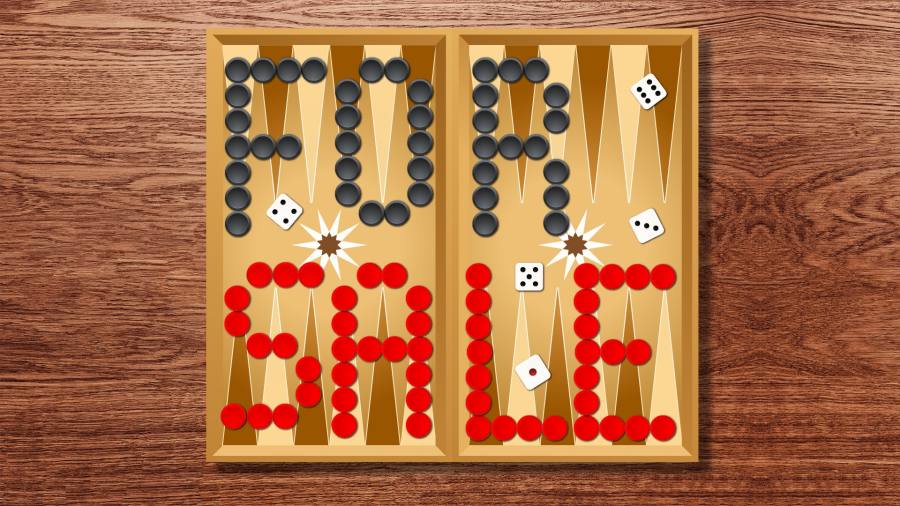Receive free Life & Arts updates
We’ll send you a myFT Daily Digest email rounding up the latest Life & Arts news every morning.
We humans have been playing backgammon in some form for five millennia. It has been unearthed by archaeologists throughout the Middle East. Egyptologists smashed into ancient tombs and discovered silver boards and ivory dice. Roman legionaries hauled the game to the far corners of their empire. Early references appear in the Babylonian Talmud.
For approximately 4,950 of those years, however, we weren’t very good, relying on feel and untested folk wisdom. But eventually sharp gamblers started writing down positions, doing the maths, picking apart the intricacies of checkers and chance. And then computer scientists built artificial neural networks and taught them the game. These systems, flawless and fearless calculators, aces at pattern recognition, play essentially perfectly. “It was painfully obvious that human beings weren’t as good as they thought they were,” Chris Bray, a backgammon author, tells me. These innovations yielded an aggressive, swashbuckling game unknown inside the pyramids.
The best backgammon player in the world today is eXtreme Gammon, universally known as XG. The artificial intelligence program was built by Xavier Dufaure de Citres, also an avid chess and bridge player, and first released in 2009. XG is the game’s swashbuckler sine qua non, its judge, jury and executioner. There isn’t a single serious player who doesn’t use it (and usually exclusively) to analyse, study and spar. At certain prestigious tournaments, it is not good enough to win — one also has to be adjudged by XG as having played better.
But Dufaure de Citres has had enough, his mark on the game long since indelible. He’s looking to sell XG and its intellectual property for between $1mn and $2mn — seven figures for backgammon’s brain.
“It’s been 35 years that I’m making backgammon software,” he says. “I’ve a bit lost the drive.”
Games have sewn together Dufaure de Citres’s personal and professional lives; he’s played them competitively and programmed them since he was eight, and they’re how he came to meet his wife and move to his current home in the US.
XG’s service, at its core, is stark quantification of human fallibility. After a match — part race, part battle, juiced up by a doubling cube — it spits out a performance rating that measures your mistakes. Zero is perfect, three is “world class”, 10 is “advanced”, 15 is “intermediate”, 30 is “beginner” and so on. I myself aim for human fallibility in the single digits.
This sort of judgment is addictive; the writing of this column has already been thrice delayed by its author playing another match. Backgammon, with its fine blend of skill and luck, is often called the cruellest game. But as you play XG, you stop caring about wins and losses, you stop worrying about luck, you stop riding the emotional rollercoaster — you only care about playing well. The quality of human backgammon play, therefore, has risen dramatically over the past decade.
“And then it doesn’t even matter what your dice are or whatever will be the outcome,” Dufaure de Citres says. “I think this makes it much more enjoyable for people.”
Indeed it does. But is this healthy emphasis on process over product worth $1mn? Perhaps — though XG does promise more concrete revenue streams. The software retails for $60 ($10 on mobile) and is licensed to commercial websites that access its application programming interface. And it is overdue for an aesthetic refresh, which could entice new players and users.
But, most of all, ownership of XG promises outsize influence over an ancient game. Every cranny of gammonworld is infiltrated by the machine, including my own scrappy club, which meets at a bar in Brooklyn. One regular suspends a camera above the board, to annotate and analyse the games after the fact. “I’ve never had a coach except XG,” that regular, Brad Mielke, tells me. “It’s my teacher, my mentor and my disciplinarian.”
Even those more circumspect about the machine’s prowess still respect it. “It may be correct, but it’s not right,” says Jeremiah Cebulski, another club member who may have come off a recent losing session or two. Our club briefly discussed pooling our money to buy XG, to exercise our own scrappy influence over the game, but no bid has yet been agreed. Dufaure de Citres says he’s received a couple of serious inquiries thus far, and he’s consulting with his lawyer.
Even some ardent devotees wonder about the sticker price. Backgammon is a complex game — the inscrutable triangles, the combinatorial mathematics, the doubling cube — and has thus far failed, though it richly deserves it, to secure the primetime audience of poker or chess.
“The problem with backgammon is it’s just that little bit too difficult for the man in the street to understand,” Bray says. “His current valuation is way too high for something that is a niche market.”
Or, rather than spend a million dollars, perhaps some new young coder will develop the next backgammon demigod in their bedroom, its insights rippling the fabric of the ancient game yet again.
Dufaure de Citres has thus far been reluctant to advertise the sale; he badly wants a buyer who respects the program, the game and the community. A mind — even an artificial one — is a terrible thing to waste. Dufaure de Citres sounds a little sad about letting it go.
“I don’t want the software to die,” he says.
Oliver Roeder is the FT’s US senior data journalist and the author of “Seven Games: A Human History” (WW Norton)
Follow @FTMag on Twitter to find out about our latest stories first
Read the full article here



